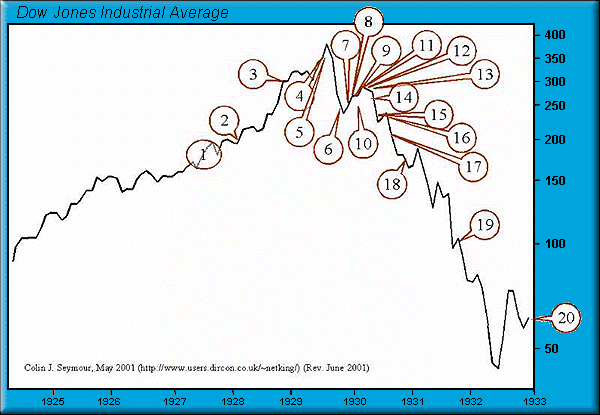This is a post from last April that I want to bring back to the forefront.
Below, I’ve liberally excerpted from an article I read a couple years back that always stuck with me.
Since our challenge today is to know whom to trust and which story to believe, I thought I’d bring this one
back to the forefront, because the parallels are so striking between the late 1920’s and now.
Below is a graph of the Dow Jones during the years of the 1920’s bubble, the stock market crash of 1929, and the onset of the Great Depression. The numbers in bubbles indicate when one or more quotes from a famous expert were captured.
I happen to believe that we are somewhere between points #8 and #18.
I get chills every time I re-read them…

Link to original article at Gold-Eagle.com
Number 7:
"The decline is in paper values, not in tangible goods and services…America is now in the eighth year of prosperity as commercially defined. The former great periods of prosperity in America averaged eleven years. On this basis we now have three more years to go before the tailspin."
– Stuart Chase , NY Herald Tribune, November 1, 1929
"Hysteria has now disappeared from Wall Street."
– The Times of London, November 2, 1929
"The Wall Street crash doesn’t mean that there will be any general or serious business depression… For six years American business has been diverting a substantial part of its attention, its energies and its resources on the speculative game… Now that irrelevant, alien and hazardous adventure is over. Business has come home again, back to its job, providentially unscathed, sound in wind and limb, financially stronger than ever before."
– Business Week, November 2, 1929
"…despite its severity, we believe that the slump in stock prices will prove an intermediate movement and not the precursor of a business depression such as would entail prolonged further liquidation…"
– Harvard Economic Society (HES), November 2, 1929
Number 8:
"… a serious depression seems improbable; [we expect] recovery of business next spring, with further improvement in the fall."
– HES, November 10, 1929
"The end of the decline of the Stock Market will probably not be long, only a few more days at most."
– Irving Fisher, Professor of Economics at Yale University, November 14, 1929
"In most of the cities and towns of this country, this Wall Street panic will have no effect."
– Paul Block (Pres. of the Block newspaper chain), editorial, November 15, 1929
"Financial storm definitely passed."
– Bernard Baruch, cablegram to Winston Churchill, November 15, 1929
Number 9:
"I see nothing in the present situation that is either menacing or warrants pessimism… I have every confidence that there will be a revival of activity in the spring, and that during this coming year the country will make steady progress."
– Andrew W. Mellon, U.S. Secretary of the Treasury December 31, 1929
"I am convinced that through these measures we have reestablished confidence."
– Herbert Hoover, December 1929
"[1930 will be] a splendid employment year."
– U.S. Dept. of Labor, New Year’s Forecast, December 1929
Number 10:
"For the immediate future, at least, the outlook (stocks) is bright."
– Irving Fisher, Ph.D. in Economics, in early 1930
Number 11:
"…there are indications that the severest phase of the recession is over…"
– Harvard Economic Society (HES) Jan 18, 1930
Number 12:
"There is nothing in the situation to be disturbed about."
– Secretary of the Treasury Andrew Mellon, Feb 1930
Number 13:
"The spring of 1930 marks the end of a period of grave concern…American business is steadily coming back to a normal level of prosperity."
– Julius Barnes, head of Hoover’s National Business Survey Conference, Mar 16, 1930
"… the outlook continues favorable…"
– HES Mar 29, 1930
Number 14:
"… the outlook is favorable…"
– HES Apr 19, 1930
Number 15:
"While the crash only took place six months ago, I am convinced we have now passed through the worst — and with continued unity of effort we shall rapidly recover. There has been no significant bank or industrial failure. That danger, too, is safely behind us."
– Herbert Hoover, President of the United States, May 1, 1930
"…by May or June the spring recovery forecast in our letters of last December and November should clearly be apparent…"
– HES May 17, 1930
"Gentleman, you have come sixty days too late. The depression is over."
– Herbert Hoover, responding to a delegation requesting a public works program to help speed the recovery, June 1930
Number 16:
"… irregular and conflicting movements of business should soon give way to a sustained recovery…"
– HES June 28, 1930
Number 17:
"… the present depression has about spent its force…"
– HES, Aug 30, 1930
Number 18:
"We are now near the end of the declining phase of the depression."
– HES Nov 15, 1930
Number 19:
"Stabilization at [present] levels is clearly possible."
– HES Oct 31, 1931
Number 20:
"All safe deposit boxes in banks or financial institutions have been sealed… and may only be opened in the presence of an agent of the I.R.S."
– President F.D. Roosevelt, 1933


